Bicycle vacation Malaysia
From Bangkok to Singapore by bicycle (II)
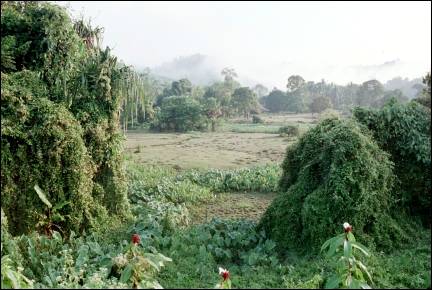
|
Bicycling along endless rice fields and in tropical rainforest, where signs warn you for "crossing elephants". In Muslim villages, signs show how to wear a veil. One day it's slipping and sliding over tree roots, another day it's walking between the tops of giant trees.
Travelogue & photos: Aart Dijkzeul
After a night in which we hardly got any sleep, we're on the ferry to Langkawi. This island is, I guess, not like the rest of Malaysia. It's clean, pretty and wealthy. In constrast to Thailand, which we just left, we see medium-range cars. Everything looks as if it's maintained well, and people here don't live in huts, but in houses. In the next couple of weeks we'll see if the mainland looks like this.
Today, our first day on the mainland, our destination is Alor Setar. On the way, the surroundings look like our native Holland. Lots of water, both from above and in the landscape. The endless rice fields, separated by irrigation canals, look like the green pastures at home. It also seems as if all Malaysians are on their way to visit gramps. So many cars; all of them stuffed with people in their best clothes. It's very colorful.
X-mas in Malaysia. The first catholic church we see in the five weeks of our trip in Asia happens to be in the town where we find ourselves on X-mas Eve (Sungai Petani). We have no choice but to attend the night mass. It's an X-mas service with all doors and windows open and fans working at full power. The words and the songs are in Chinese, Malaysian and English (there are many people of Indian descent). Because there is no instantaneous interpretation, the service takes a long time.
On X-mas morning I wake up early because of rumbling in my intestines. I always thought that all that tepid food, kept in pots and pans for the whole day until it is eaten, can't be healthy. It's bound to be a breeding ground for bacteria.
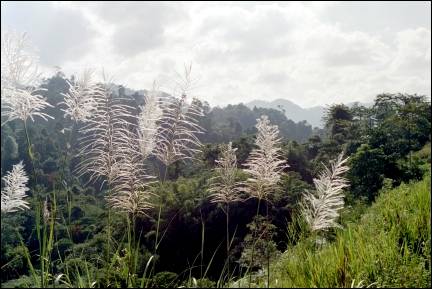
|
Bicycling is not much fun with all those stops I have to make. Also, during the short periods of time when I sit with my pants around my ankles, insects take the opportunity to bite me. But the next day, I'm fine.
During the days that follow, we cross from one side of Malaysia to the other. A beautiful trip through tropical rainforest. 200 km of this distance we bicycle on the East-West Highway, the only cross-country connection in the north of the country. It sounds grand, but there are no more cars than on a secondary road in a sleepy hinterland.
Every now and then we pass a sign "crossing elephants". Unfortunately, we don't see any. We have to be satisfied with sounds, footprints, the scent that one also smells in the zoo and the turds.
Banding
We follow elephant trails for a couple of hours
Half way our trip we stay for one day in a completely deserted place (Banding). We hire a guide for a jungle tour. For hours, we climb along elephant paths. We never knew that these unwieldy animals could walk such steep, slippery and narrow paths.
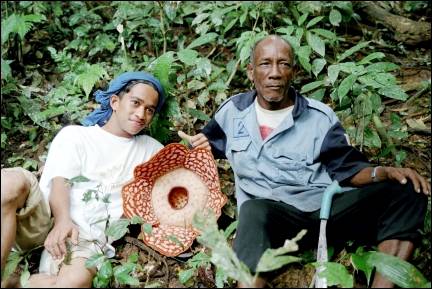
|
Everything is overgrown with ferns, shrubs and giant trees. There are lots of leeches. We have to stop every five minutes to remove everything that is feeding on us. Highlight of the tour is a blossoming Raflesia. A red flower of an epiphyte with a 50-60 centimeters diameter.
Next day, we reach the highest point of our trip, about 1200 meters. It's a 30 km climb until we reach the top. Once there, there's wind and heavy rain, we're surrounded by clouds, so we hardly have a view, and it's cold. Fortunately, we're compensated with beautiful views of patches of clouds and fog rising from the jungle and waterfalls and peace and quiet. And of course a thirty km descent.
Kelatan
The most orthodox Muslim province
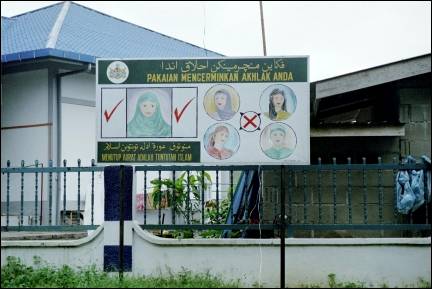
|
After our descent we arrive in the province of Kelatan. It is the most orthodox Muslim province of Malaysia. We can't get beer here, to mention the most important consequence.
In Jeli's market place sits a big sign with instructions how the veil should and how it shouldn't be worn.
But the people aren't any less nice for it. When we have dinner somewhere, our table gets an extra cleaning. With a cloth with which I wouldn't clean my bike, but it's the thought that counts. Other customers and neighbors are recruted to help overcome the language barrier.
We're in Kuala Krai now and take a trip to the capital of the province, Kota Bharu. In Muslim circles, Kota Bharu is also known as the Mecca of Asia. It shows. Many women wear head scarves and the man wear white caps. The muezzins are very much present as well.
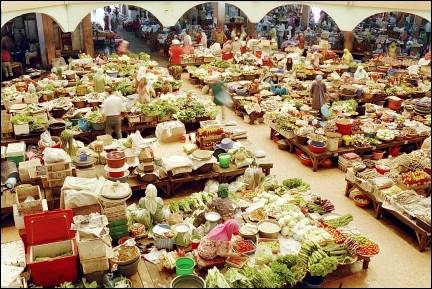
|
When shopping in a supermarket, one has to pay attention at which cash register on checks out: there are seperate ones for men and women. I notice too late that I'm in the wrong line, but they don't hold it against me.
Eating is also subjected to the Islamic timetable. On our first day we have dinner on the Pasar Malam (evening market). When we have just started to eat, there is a public anouncement that we don't understand. A little later, someone tells us that we're supposed to leave at 7:15 PM.
Just before 7:15 PM, someone tells us again and exactly at 7:15 PM the lights in the stalls are switched off. Immediately the place is deserted. Evening prayers. Half an hour later, everything is in full swing again.
It's an enormous Pasar Malam. At 5 PM it's still a parking lot; at six there are tens of stalls with tables and chairs between them. The ordered food is wrapped in grease-proof paper and a plastic bag.
Then one can sit down and order a drink. Most Malaysians - at least here - eat with their hands. Fortunately, utensils are available at the stalls where one orders a drink.
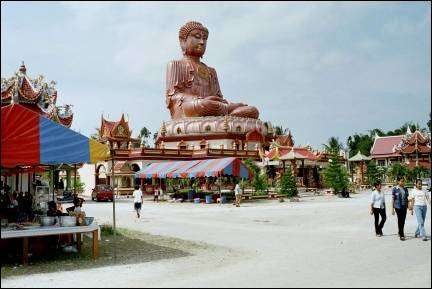
|
There is a huge variety of food: white, yellow or blue rice; all kinds of fish and meat. Even dried jellyfish is eaten (not by us).
By bike, we visit temples: Chinese, Buddhist and Hindu. It's as if they want to outdo each other, because one is even more beautiful and larger than the other. Buddha statues measure tens of meters. Brightly colored dragons and snakes decorate the Chinese temples.
This trip is a disaster
We have to climb whole stretches, holding on to tree roots
Today we make a tour of the kampongs by bike. The schools are closed for vacations; so we are constantly followed and surrounded by groups of children. Which is still fun, by the way.
The kampongs are vastly different. The ones that we pass by bike, have 15-50 dwellings (everything from huts to luxury houses) along a narrow road. Usually the houses are surrounded by palm trees.
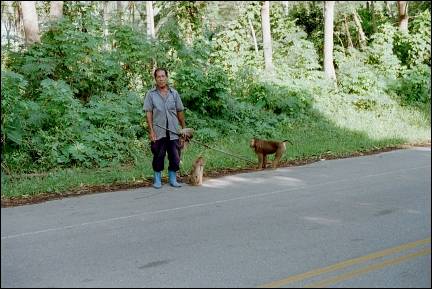
|
Around some of the houses we see monkeys on leashes, which are used to pick coconuts. Fortunately no dogs. There are goats, chickens and cows along the road. They all roam free.
We are at the center of Malaysia, in a hamlet with the graceful name Jerantut. Except for elephant and airplane, we have used all means of transportation this week: Boat, train, feet, bus and of course bicycle.
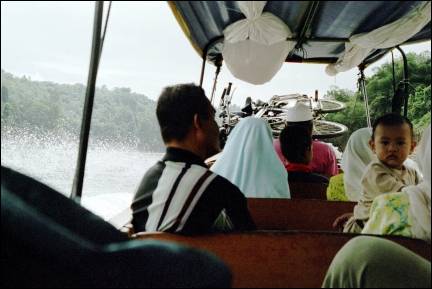
|
It starts with a boat trip on the Kelantan, a wide river. The town that we want to visit (Dabong) cannot be reached by bike.
It's a small, open boat, as wide as a rowing boat but three times as long. It has ten seats (planks) and a diesel motor that is strong enough to push a twenty-tons truck up a mountain. So we go fast. But it's also noisy. It's a wonderful trip, over two hours through the jungle.
After our arrival, we bicycle a little farther to the place where we want to spend the night: a group of cottages at the foot of a waterfall. Unfortunately, it's closed. And there we are, in the middle of nowhere, it's raining and not a hotel or resort within 80 kilometers.
We don't want to go back, because we want to hike to the top of the waterfall tomorrow. But more important: we can't go back, because there is only one boat every day. We look around and see that one of the doors of a building is open. A conference room. Looks great to spend the night in.
Just when we want to install ourselves there, someone enters and tells us that he has a "camp" at the top of the waterfall. We can come with him, spend the night there and go hiking with him tomorrow to the top of the next waterfall. There is a series of seven.
Quickly we put some stuff in our backpacks; we store our bike packs in the building with the open door and park our bikes out of sight.
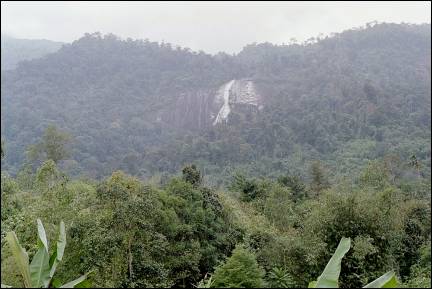
|
It's only an hour, says Tony. Climbing, clambering, slipping and sliding. It's a disaster. It's not a little steep, it's terribly steep. We have to climb for whole stretches, holding on to tree roots; other parts seem to have been rubbed with soap to make them slippery.
We're exhausted when we reach our destination. Our desire to go hiking next day, and more in general, our desire to walk in a rain forest, has disappeared completely.
Baha's camp turns out to be a collection of ten extremely rickety cabins without gas, light or water. The roofs leak and the camp is inhabited by eight people who work as guides during the dry season. Meanwhile, we found out that this is the wet season.
Next day we go for a short hike. We didn't like the climbing, but descending is three times as bad. Completely against my nature, I say quick prayers. In my mind's eye, I see images of doom: sprained ankles, broken legs and worse. The prayers are successful, because we get downhill in one piece. Except for a few scrapes.
We are happy and relieved. Everything is still in one piece; we can get on our bikes again, and it's just the two of us. Our happiness subsides next day. It turns out that one uses different muscles for climbing than for bicycling.
Kuala Lumpur
They don't care about copyrights here
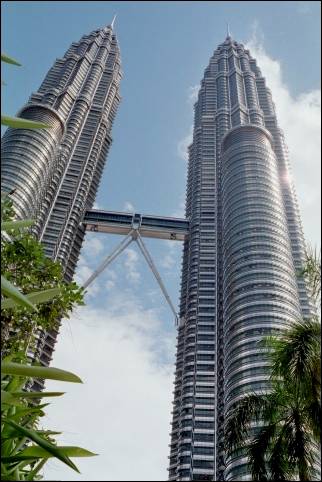
|
In Dabong we take the train to Kuala Lipis. And from there a bus to Kuala Lumpur, Malaysia's capital. For 200 km, four hours, we fly (or so it feels) in a luxury bus and we're there.
KL, as everyone calls the city here, has - like every metropolis - sharp contrasts. A rich part with shopping malls and very tall buildings. The Petronas Towers are the highest buildings in the world. In that area we also see some buildings that were left half-constructed because of the Asian financial crisis at the end of the twentieth century.
Some streets are even classy. Others show the usual Asian image: narrow, untidy streets with all kinds of merchandise. They don't care about copyrights here. A Harry Potter DVD only costs 1.5 euro, the same goes for Windows XP.
The interesting part of the city isn't very large; everything can be visited on foot, provided you're a reasonable hiker and have the guts to cross busy thru-ways running a kind of slalom. The city can't be called pedestrian friendly.
Taman Negara
A rope bridge between the tops of giant trees
Today, we are back on our bikes. The route we take is beautiful and rather hilly. We see and hear lots of monkeys. Usually they scamper off when we pass. So there is no opportunity for extensive monkey watching.
From Jerantut, the geografic center of Malaysia, we travel to Taman Negara, the oldest and largest National Park of Malaysia. Both ways, a boat takes us up and down the Pahang river (60 km).
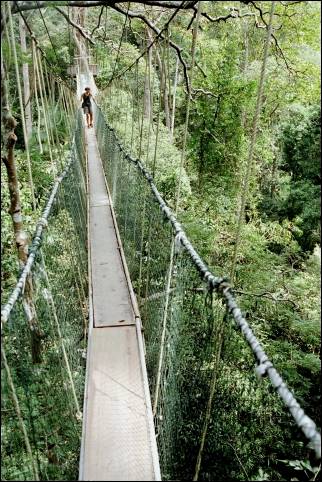
|
Taman Negara is gorgeous - at the least the small section of it that we get to see. Despite our decision not to take any jungle hikes, we can't resist the temptation and take a few walks. They are easier than the ones we took before.
This way, it's also easier to get a good look at everything. Trees up to eighty meters with a dense undergrowth of smaller trees, ferns, bamboo, rotan, etc. beneath them.
The park is known for its Canopy Walk: a rope bridge between giant trees, at a height of 25-50 meters and with a length of 500 meters. It offers a unique view of the forest. Beneath us, we see the lower vegetation and above our heads, the giant trees tower over us.
The following days we bicycle again and establish two records: the shortest (32 km) and the longest (140 km) stages. Especially the long one is great. We get up early; the world is so beautiful at that time. Everything is damp; patches of fog and many birds. We are surrounded by jungle and every now and then there's a fruit plantation. A lot of variation and a pleasant road to bicycle on.
The area (and the road) where we ride, was flooded three weeks ago. We can still see the mud and the "plastic line" on branches and leaves of trees and shrubs. The whole area, including houses and roads, was flooded. If we had visited a month ago, we would have had to turn back.
Part of the plastic that the Malaysians throw out, now decorates the trees. Roadsides, yards, and the surroundings of restaurants are often covered in street litter. And if there is a thrashcan, monkeys take the garbage and throw it back on the street, searching for food.
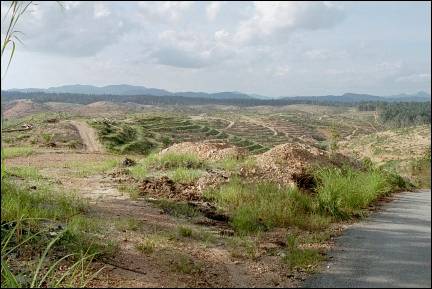
|
At two-thirds of the distance, we cross the Pahang river. It's not easy to load the bikes on the small boat; the wheels stick out, but we reach our destination: the other side of the river.
It's really different here. Many plantations and plantations under construction. At one point, we're in a spot where for many kilometers around us, the forest has been cut down. On the hills, terraces are built on which small palm trees are planted. It makes us sad. An irreversible intervention that destroys so much beautiful nature.
Back to the coast
With the wind in our backs along the South Chinese Sea
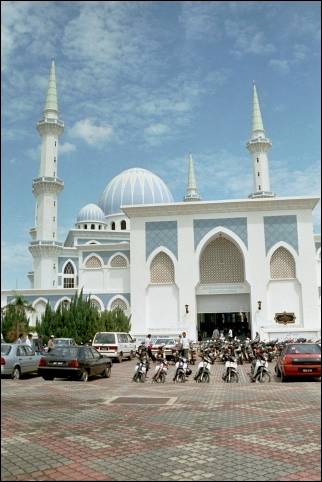
|
From Lake Chini (the destination of the long route) we bicycle back to the coast. To Pekan, where the sultan lives. Most states in Malaysia are governed by a sultan. His palace is something. It would make our queen jealous.
We stay in the guest accomodation of the local polo club. It's one of those old colonial buildings and the kind of club one imagines for the noble game of polo. The British clearly had more influence on this country's culture than the Dutch, who also ruled here for a while. We haven't seen even one clog-dance club so far!
We take the bus in Pekan to visit the capital of the state Pahang for a day. It has the largest mosque of the country. A stunningly beautiful building. The Friday-afternoon prayers are being said, so we can't enter.
It's an enigma to me how those Muslims find their slippers after the prayer service.
Today we bicycle farther south. To our left is the South Chinese Sea and to our right swamps, alternated with "lowland jungle". A pretty route, with the wind in our backs. And it will stay that way, because there's a north-east monsoon.
This last part of our trip isn't tough at all. The last stages are just slightly hilly. On the other hand, it's a little more crowded.
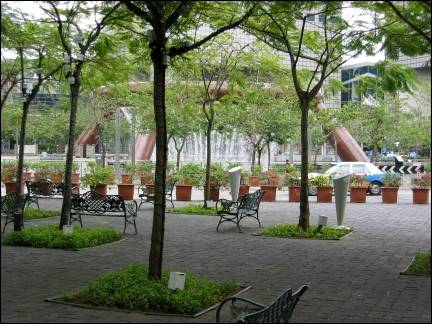
|
To compensate for that, we travel to the island of Tioman for a few days. It's situated 50 km off the coast and is described in the Lonely Planet as "pretty and quiet". And that is exactly what it is. It's mostly unspoiled.
That is mainly because there is only one road, which is only 2 km long and narrow. No cars, only mopeds with sidecars which are used by the local population to transport children, mortar and rice. It's sparsely populated anyway. The water is very clear and snorkeling here is a breath-taking experience.
Singapore, the final destination of this trip, is an extremely organized, clean and efficient city. It's as stark a contrast as possible with Thailand and Malaysia.